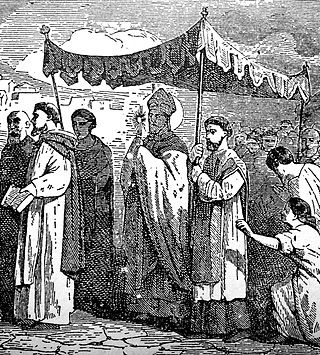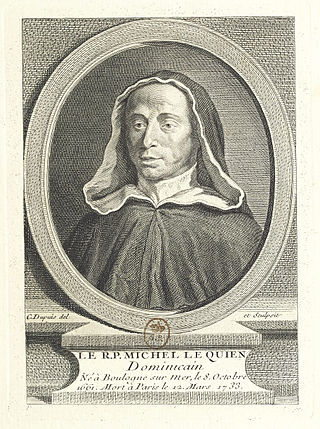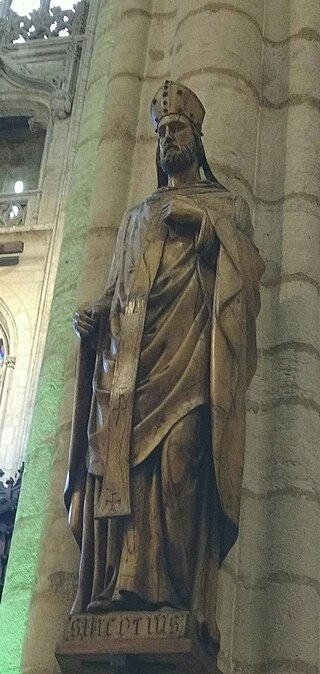Related Research Articles
Pope Sixtus III was the bishop of Rome from 31 July 432 to his death on 18 August 440. His ascension to the papacy is associated with a period of increased construction in the city of Rome. His feast day is celebrated by the Roman Catholic Church and Eastern Orthodox Church on 28 March.
Pope Sergius II was the bishop of Rome and ruler of the Papal States from January 844 to his death in 847. Sergius II's pontificate saw the Arab raid against Rome as well as the city's redevelopment.
Vincent of Lérins was a Gallic monk and author of early Christian writings. One example was the Commonitorium, c. 434, which offers guidance in the orthodox teaching of Christianity. Suspected of semi-Pelagianism, he opposed the Augustinian model of grace and was probably the recipient of Prosper of Aquitaine's Responsiones ad Capitula Objectionum Vincentianarum. His feast day is celebrated on 24 May.

Melchor Cano was a Spanish Scholastic theologian. Cano's most important theological work was his posthumously published De locis theologicis, a major contribution to the New Scholasticism of the Salamanca school.

Eustathius of Antioch, sometimes surnamed the Great, was a Christian bishop and archbishop of Antioch in the 4th century. His feast day in the Eastern Orthodox Church is February 21.

Hincmar, archbishop of Reims, was a Frankish jurist and theologian, as well as the friend, advisor and propagandist of Charles the Bald. He belonged to a noble family of northern Francia.

Mamertus was the bishop of Vienne in Gaul, venerated as a saint. His primary contribution to ecclesiastical practice was the introduction of litanies prior to Ascension Day as an intercession against earthquakes and other disasters, leading to "Rogation Days." His feast day is the first of the Ice Saints.
The Latin term primicerius, Hellenized as primikērios, was a title applied in the later Roman Empire and the Byzantine Empire to the heads of administrative departments, and also used by the Church to denote the heads of various colleges.
Agobard of Lyon was a Spanish-born priest and archbishop of Lyon, during the Carolingian Renaissance. The author of multiple treatises, ranging in subject matter from the iconoclast controversy to Spanish Adoptionism to critiques of the Carolingian royal family, Agobard is best known for his critiques of Jewish religious practices and political power in the Frankish-Carolingian realm. He was succeeded by Amulo of Lyons.
The von Hurter family belonged to the Swiss nobility; in the eighteenth and nineteenth centuries three of them were known for their conversions to Roman Catholicism, their ecclesiastical careers in Austria and their theological writings.

The Martyrology of Usuard is a work by Usuard, a monk of the Benedictine abbey of Saint-Germain-des-Prés. The prologue is dedicated to Charles the Bald indicating that it was undertaken at that monarch's instigation. It was apparently written shortly before the author's death in 875. The martyrology enjoyed consistent success throughout the Middle Ages, as evidenced by numerous surviving manuscripts. This martyrology synthesizes elements of the old Martyrologium Hieronymianum, the martyrology of Ado of Vienne, and an enhanced version of that of Bede, attributed to the archdeacon Florus of Lyon. It contains eleven hundred saints' lives. The martyrology is a compilation upon which the later Roman Martyrology depended closely until the twentieth century; it remained throughout the Middle Ages the most famous document of its kind. It is preserved to us in innumerable manuscripts, of which Henri Quentin gives a partial list.

The Archdiocese of Lyon, formerly the Archdiocese of Lyon–Vienne–Embrun, is a Latin Church metropolitan archdiocese of the Catholic Church in France. The archbishops of Lyon are also called primates of Gaul. An archbishop is usually elevated by the pope to the rank of cardinal.
Amalarius (c. 775–c. 850) was a Frankish prelate and courtier, temporary bishop of Trier (812–13) and Lyon (835–38), and an accomplished liturgist. He was close to Charlemagne and a partisan of his successor, Louis the Pious, throughout the latter's tumultuous reign.

Michel Le Quien was a French historian and theologian.

Saint Nicetius was Archbishop of Lyon, then Lugdunum, France, during the 6th century. He served from 552 or 553. He is venerated as a saint in the Catholic Church.
Fridugisus, also known as Fredegisus or Fredegis of Tours, was a monk, teacher, and writer.
Moduin, Modoin, or Mautwin was a Frankish churchman and Latin poet of the Carolingian Renaissance. He was a close friend of Theodulf of Orléans, a contemporary and courtier of the emperors Charlemagne and Louis the Pious, and a member of the Palatine Academy. In signing his own poems he used the pen name Naso in reference to the cognomen of Ovid. From 815 until his death he was the Bishop of Autun.
Spanish Adoptionism was a Christian theological position which was articulated in Umayyad and Christian-held regions of the Iberian Peninsula in the 8th- and 9th centuries. The issue seems to have begun with the claim of archbishop Elipandus of Toledo that – in respect to his human nature – Jesus Christ was adoptive Son of God. Another leading advocate of this Christology was Felix of Urgel. In Spain, Adoptionism was opposed by Beatus of Liebana, and in the Carolingian territories, the Adoptionist position was condemned by Pope Hadrian I, Alcuin of York, Agobard, and officially in Carolingian territory by the Council of Frankfurt (794).
Amulo served as Archbishop of Lyon from 841 to 852 AD. As a Gallic prelate, Amulo is best known for his letters concerning two major themes: Christian–Jewish relations in the Frankish kingdom and the Carolingian controversy over predestination. He was ordained as archbishop in January 841.

Leidrad was the bishop of Lyon from 797 and its first archbishop from 804 until 814. He was a courtier of Charlemagne before he was a bishop. As bishop, he helped resolve the adoptionist controversy. He also began a programme of building and renovation in his diocese, turning Lyon into a centre of learning. Of his writings, two letters and a treatise on baptism survive.
References
- 1 2 History of the Christian Church, Volume IV: Mediaeval Christianity. A.D. 590-1073, (Philip Schaff, ed.) 1910, Charles Scribner’s Sons
 This article incorporates text from this source, which is in the public domain .
This article incorporates text from this source, which is in the public domain . - 1 2 Kirsch, Johann Peter. "Florus." The Catholic Encyclopedia Vol. 6. New York: Robert Appleton Company, 1909. 10 January 2023
 This article incorporates text from this source, which is in the public domain .
This article incorporates text from this source, which is in the public domain . - ↑ West, Charles. "How to become bishop: ecclesiastical liberty in the ninth century", Turbulent Priests, Department of History, Sheffield
- ↑ McCracken, Early Medieval Theology, 330.
- ↑ Ginther, James R., Westminster Handbook to Medieval Theology, 9.
- ↑ Flori Lugdunensis Opera Omnia: Corpus Christianorum Continuatio Mediaeualis, Turnhout: Brepols, from 2002.